课程地址:https://learn.deeplearning.ai/courses/function-calling-and-data-extraction-with-llms/lesson/1/introduction
github notebook地址:https://github.com/kingglory/LLMs-function-calling/tree/main
Function-Calling 介绍
函数调用(Function-Calling)允许使用自定义功能扩展LLM,使它们能够根据自然语言指令形成对外部函数的调用。结构化数据提取使LLM能够从非结构化文本中提取可用信息。
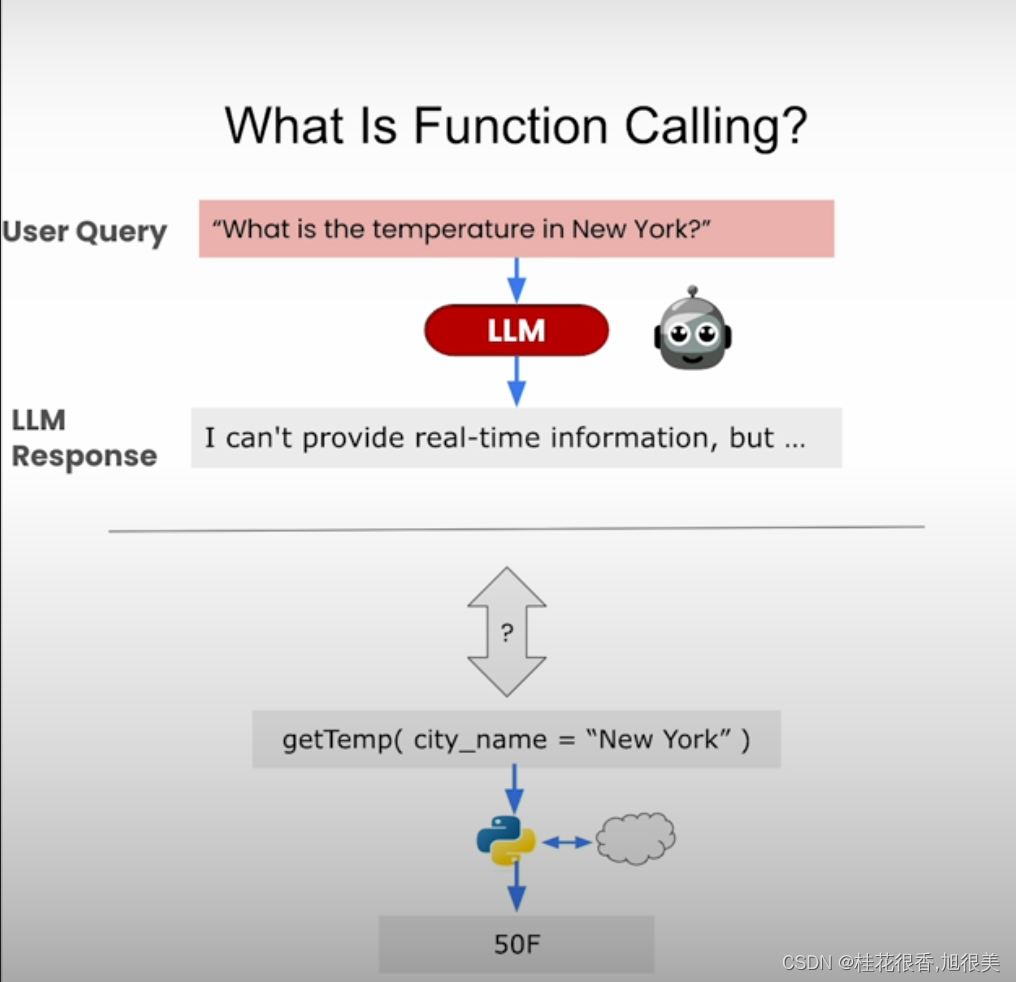
Function-calling is the capability of an LLM to take in a natural language query, along with a description of the function,and output a string that can be used to call that function.
Function-calling是LLM接收自然语言查询以及函数描述,并输出可用于调用该函数的字符串的能力。

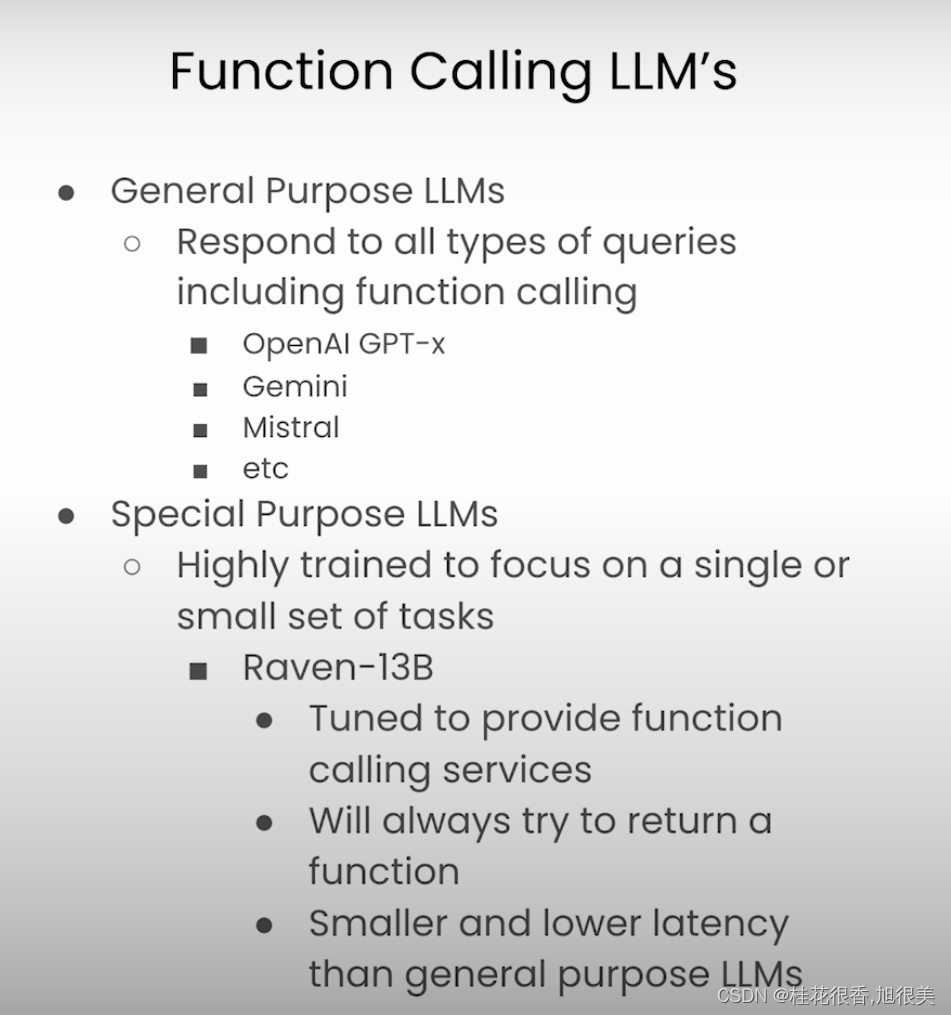
先使用NexusRavenV2-13B 大模型,一个针对函数调用(function-calling)和数据提取进行了微调的开源模型。该模型可在Hugging Face上使用,在一些函数调用任务中表现优于GPT-4,并且具有130亿个参数,因此可以在本地托管。
写一个python tool
from matplotlib import pyplot as plt
def plot_some_points(x : list, y : list):
"""
Plots some points!
"""
plt.plot(x, y)
plt.show()
USER_QUERY = "Hey can you plot y=10x where x=1, 2, 3 for me?"
plot_some_points(x=[1, 2, 3], y=[10, 20, 30])
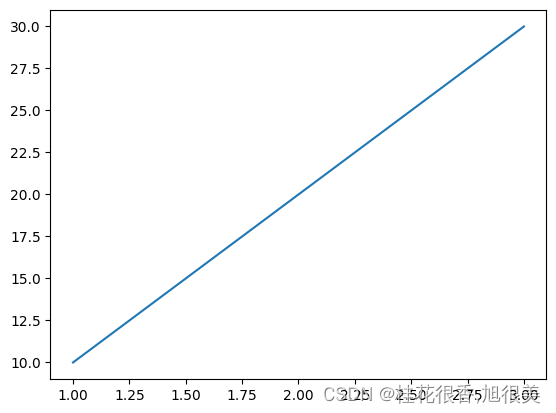
想让大模型帮我们做上面的事,首先要给出一个tool 描述(description)和user query 给LLM。
- 你首先要提供前面使用的函数的原型。
- 你将要使用的LLM使用python格式的函数。
- 你还将添加一些关于工具功能的描述。LLM会根据描述来判断是否应该使用该工具来回答用户查询的推理。
- 你还需要提供LLM 用户的输入(user query)
prompt = \
f'''
Function:
def plot_some_points(x : list, y : list):
"""
Plots some points!
"""
plt.plot(x, y)
plt.show()
User Query: {USER_QUERY}<human_end>
'''
# 这个大模型是训练过的,专门针对function-calling ,这里是接口调用,返回function-calling字符串
# def raven_post(payload):
# """
# Sends a payload to a TGI endpoint.
# """
# # Now, let's prompt Raven!
# API_URL = "http://nexusraven.nexusflow.ai"
# headers = {
# "Content-Type": "application/json"
# }
# import requests
# response = requests.post(API_URL, headers=headers, json=payload)
# return response.json()
# def query_raven(prompt):
# """
# This function sends a request to the TGI endpoint to get Raven's function call.
# This will not generate Raven's justification and reasoning for the call, to save on latency.
# """
# import requests
# output = raven_post({
# "inputs": prompt,
# "parameters" : {"temperature" : 0.001, "stop" : ["<bot_end>"], "return_full_text" : False, "do_sample" : False, "max_new_tokens" : 2048}})
# call = output[0]["generated_text"].replace("Call:", "").strip()
# return call
from utils import query_raven
function_call = query_raven(prompt)
LLM function-calling 的结果是一个字符串: 函数名被调用的状态,并包含输入参数,然后exec 执行一下就会执行这个函数(tool)
print (function_call)
plot_some_points(x=[1, 2, 3], y=[10, 20, 30])
exec 执行储存在字符串或文件中的 Python 语句,相比于 eval,exec 可以执行更复杂的 Python 代码。https://www.runoob.com/python3/python3-func-exec.html
exec 的语法: exec(object[, globals[, locals]])
- object:必选参数,表示需要被指定的 Python 代码。它必须是字符串或 code 对象。如果 object 是一个字符串,该字符串会先被解析为一组 Python 语句,然后再执行(除非发生语法错误)。如果 object 是一个 code 对象,那么它只是被简单的执行。
- globals:可选参数,表示全局命名空间(存放全局变量),如果被提供,则必须是一个字典对象。
- locals:可选参数,表示当前局部命名空间(存放局部变量),如果被提供,可以是任何映射对象。如果该参数被忽略,那么它将会取与 globals 相同的值。
exec 返回值永远为 None。
>>>exec('print("Hello World")')
Hello World
# 单行语句字符串
>>> exec("print ('runoob.com')")
runoob.com
# 多行语句字符串
>>> exec ("""for i in range(5):
... print ("iter time: %d" % i)
... """)
iter time: 0
iter time: 1
iter time: 2
iter time: 3
iter time: 4
exec(function_call)
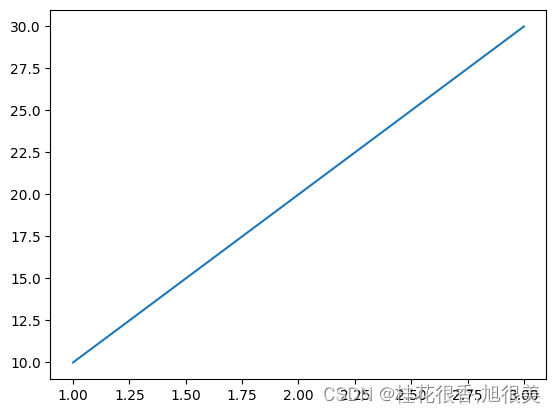
再试一个
USER_QUERY = "帮我画个y=x**3, 其中 x = 1,2,3, 4, 5"
prompt = \
f'''
Function:
def plot_some_points(x : list, y : list):
"""
Plots some points!
"""
plt.plot(x, y)
plt.show()
User Query: {USER_QUERY}<human_end>
'''
from utils import query_raven
function_call = query_raven(prompt)
exec(function_call)

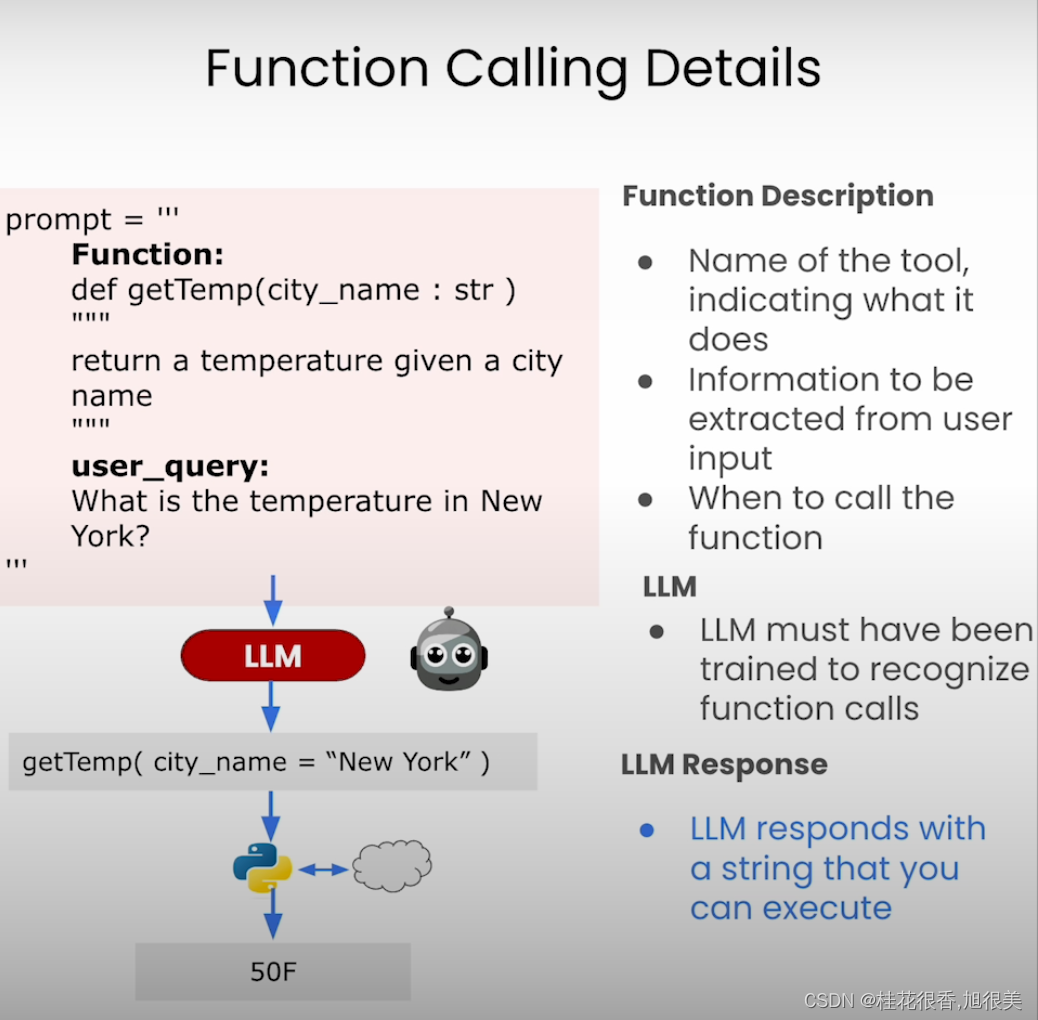
试一个复杂的例子
定义一个函数
# 提供 脸的颜色, 眼睛的颜色, 鼻子的颜色 画一个笑脸
import matplotlib.pyplot as plt
import matplotlib.patches as patches
def draw_clown_face(face_color='yellow', eye_color='black',
nose_color='red'):
"""
Draws a customizable, simplified clown face using matplotlib.
Parameters:
- face_color (str): Color of the clown's face. Default is 'yellow'.
- eye_color (str): Color of the clown's eyes. Default is 'black'.
- nose_color (str): Color of the clown's nose. Default is 'red'.
This function creates a plot displaying a simplified clown face, where essential facial features' size, position, and color can be customized.
"""
# Constants
face_radius = 0.4
nose_radius = 0.1
nose_x, nose_y = 0.5, 0.5
mouth_x, mouth_y = 0.5, 0.3
mouth_color = 'black'
eye_size = 0.05
mouth_size = (0.3, 0.1)
eye_offset=(0.15, 0.15)
mouth_theta = (200, 340)
fig, ax = plt.subplots()
# Face
face = patches.Circle((0.5, 0.5), face_radius, color=face_color, fill=True)
ax.add_patch(face)
# Eyes
eye_left = patches.Circle((0.5-eye_offset[0], 0.5+eye_offset[1]), eye_size, color=eye_color, fill=True)
eye_right = patches.Circle((0.5+eye_offset[0], 0.5+eye_offset[1]), eye_size, color=eye_color, fill=True)
ax.add_patch(eye_left)
ax.add_patch(eye_right)
# Nose
nose = patches.Circle((nose_x, nose_y), nose_radius, color=nose_color, fill=True)
ax.add_patch(nose)
# Mouth
mouth = patches.Arc((mouth_x, mouth_y), mouth_size[0], mouth_size[1], angle=0,
theta1=mouth_theta[0], theta2=mouth_theta[1], color=mouth_color, linewidth=2)
ax.add_patch(mouth)
# Setting aspect ratio to 'equal' to ensure the face is circular
ax.set_aspect('equal')
# Remove axes
ax.axis('off')
plt.show()
定义一个Prompt
USER_QUERY = \
"画一个白色的小丑脸和红色的鼻子吗"
raven_prompt = \
'''
Function:
def draw_clown_face(face_color='yellow',
eye_color='black',
nose_color='red'):
"""
Draws a customizable, simplified clown face using matplotlib.
Parameters:
- face_color (str): Color of the clown's face.
- eye_color (str): Color of the clown's eyes.
- nose_color (str): Color of the clown's nose.
"""
User Query: {query}<human_end>
'''
raven_prompt_with_query = raven_prompt.format(query=USER_QUERY)
print (raven_prompt_with_query)
Function:
def draw_clown_face(face_color='yellow',
eye_color='black',
nose_color='red'):
"""
Draws a customizable, simplified clown face using matplotlib.
Parameters:
- face_color (str): Color of the clown's face.
- eye_color (str): Color of the clown's eyes.
- nose_color (str): Color of the clown's nose.
"""
User Query: 画一个白色的小丑脸和红色的鼻子吗<human_end>
from utils import query_raven
raven_call = query_raven(raven_prompt_with_query)
print (raven_call)
draw_clown_face(face_color='white', nose_color='red')
Run The Call
exec(raven_call)
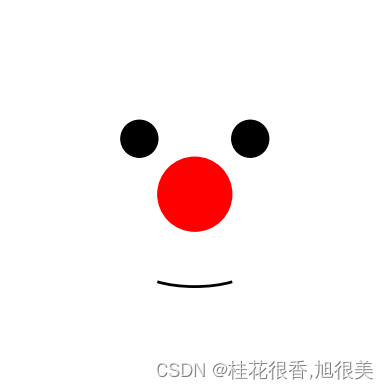
再画一个笑脸
USER_QUERY = "画一个小丑的笑脸,眼睛是白色的,脸是黑色的,嘴巴是粉色的,鼻子是大红色,耳朵就跟米老鼠一样的"
raven_prompt_with_query = raven_prompt.format(query=USER_QUERY)
from utils import query_raven
raven_call = query_raven(raven_prompt_with_query)
print (raven_call)
exec(raven_call)
draw_clown_face(face_color='black', eye_color='white', nose_color='red')
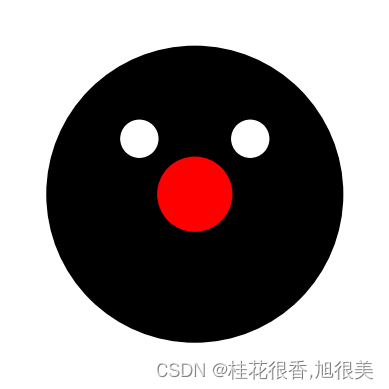
试一下 chatgpt的function-calling
import json
from openai import OpenAI
from dotenv import load_dotenv
import os
_ = load_dotenv()
def query_openai(msg, functions=None):
load_dotenv()
GPT_MODEL = "gpt-3.5-turbo"
openai_client = OpenAI(api_key=os.environ["OPENAI_API_KEY"])
openai_response = openai_client.chat.completions.create(
model = GPT_MODEL,
messages = [{'role': 'user', 'content': msg}],
tools = functions)
return openai_response
需要以json格式提供tool的描述(description)和参数(arguments)
openai_function = {
"type": "function",
"function": {
"name": "draw_clown_face",
"description": "Draws a customizable, simplified clown face using matplotlib.",
"parameters": {
"type": "object",
"properties": {
"face_color": {
"type": "string",
"description": "Color of the clown's face."
},
"eye_color": {
"type": "string",
"description": "Color of the clown's eyes."
},
"nose_color": {
"type": "string",
"description": "Color of the clown's nose."
}
}
}
}
}
openai_msg = \
"Hey can you draw a pink clown face with a red nose"
result = query_openai(openai_msg, functions=[openai_function])
print (result.choices[0].message.tool_calls[0].function)
Function(arguments='{"face_color": "pink", "eye_color": "black", "nose_color": "red"}', name='draw_clown_face')
注意!返回的结果跟之前不一样,这样的字符串是不能直接用exec执行的,所以需要一个归一化处理
tool_name = result.choices[0].message.tool_calls[0].function.name
tool_args = result.choices[0].message.tool_calls[0].function.arguments
function_call = f"{tool_name}(**{tool_args})"
print (function_call)
draw_clown_face(**{"face_color": "pink", "eye_color": "black", "nose_color": "red"})
exec(function_call)

使用训练过的LLM在非结构化数据和高度结构化的code之间搭建了桥梁!!
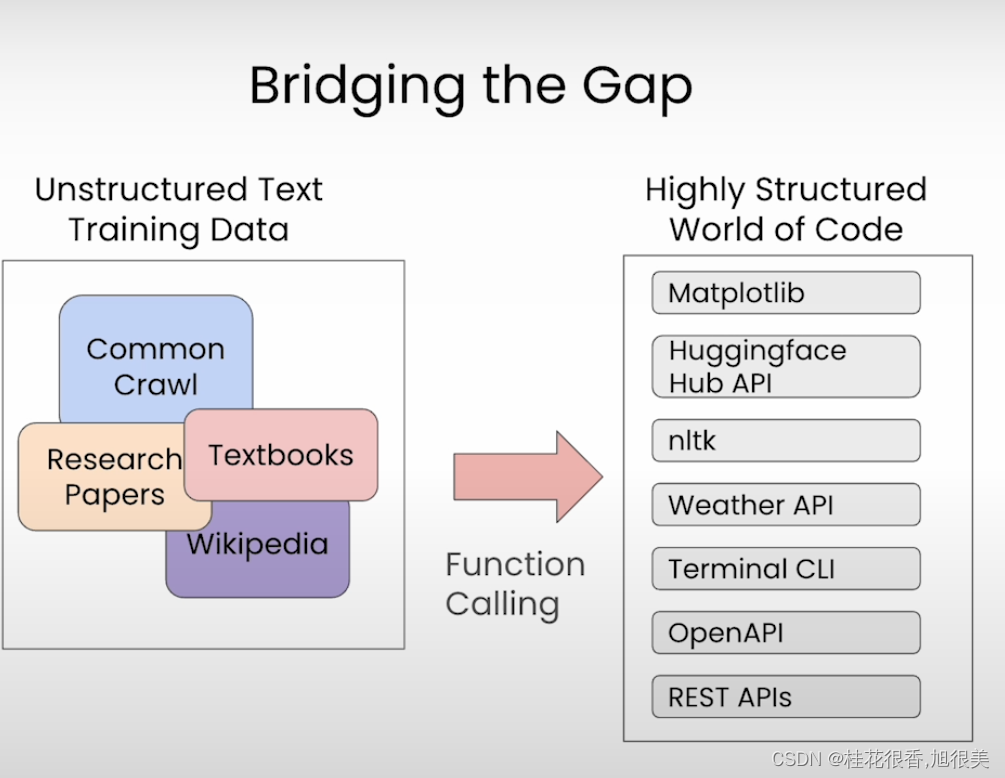
辅助函数:utils.py
import inspect
def raven_post(payload):
"""
Sends a payload to a TGI endpoint.
"""
# Now, let's prompt Raven!
API_URL = "http://nexusraven.nexusflow.ai"
headers = {
"Content-Type": "application/json"
}
import requests
response = requests.post(API_URL, headers=headers, json=payload)
return response.json()
def call_functioncalling_llm(prompt, api_to_call):
"""
This function sends a request to the TGI endpoint to get Raven's function call.
This will not generate Raven's justification and reasoning for the call, to save on latency.
"""
signature = inspect.signature(api_to_call)
docstring = api_to_call.__doc__
prompt = f'''Function:\n{api_to_call.__name__}{signature}\n"""{clean_docstring(docstring)}"""\n\n\nUser Query:{prompt}<human_end>'''
import requests
output = raven_post({
"inputs": prompt,
"parameters" : {"temperature" : 0.001, "stop" : ["<bot_end>"], "do_sample" : False, "max_new_tokens" : 2048, "return_full_text": False}})
call = output[0]["generated_text"].replace("Call:", "").strip()
return call
def query_raven(prompt):
"""
This function sends a request to the TGI endpoint to get Raven's function call.
This will not generate Raven's justification and reasoning for the call, to save on latency.
"""
import requests
output = raven_post({
"inputs": prompt,
"parameters" : {"temperature" : 0.001, "stop" : ["<bot_end>"], "return_full_text" : False, "do_sample" : False, "max_new_tokens" : 2048}})
call = output[0]["generated_text"].replace("Call:", "").strip()
return call
def clean_docstring(docstring):
if docstring is not None:
# Remove leading and trailing whitespace
docstring = docstring.strip()
return docstring
def build_raven_prompt(function_list, user_query):
import inspect
raven_prompt = ""
for function in function_list:
signature = inspect.signature(function)
docstring = function.__doc__
prompt = \
f'''
Function:
def {function.__name__}{signature}
"""
{clean_docstring(docstring)}
"""
'''
raven_prompt += prompt
raven_prompt += f"User Query: {user_query}<human_end>"
return raven_prompt

























 2035
2035











 被折叠的 条评论
为什么被折叠?
被折叠的 条评论
为什么被折叠?








